同济大学:《大学物理》课程教学资源(电子教案,英文版)第十三章 高斯定律
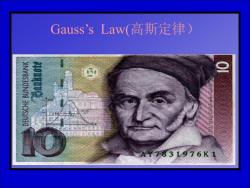
Gauss'sLaw(高斯定律) XNV8SJGNN8 3HDSIn3 AY7831976K1
Gauss’s Law(高斯定律)
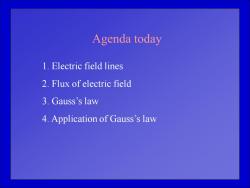
Agenda today 1.Electric field lines 2.Flux of electric field 3.Gauss's law 4.Application of Gauss's law
Agenda today 1. Electric field lines 2. Flux of electric field 3. Gauss’s law 4. Application of Gauss’s law
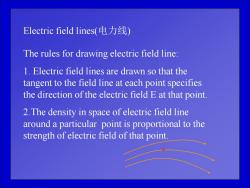
Electric field lines(电力线) The rules for drawing electric field line: 1.Electric field lines are drawn so that the tangent to the field line at each point specifies the direction of the electric field E at that point. 2.The density in space of electric field line around a particular point is proportional to the strength of electric field of that point
Electric field lines(电力线) The rules for drawing electric field line: 1. Electric field lines are drawn so that the tangent to the field line at each point specifies the direction of the electric field E at that point. 2.The density in space of electric field line around a particular point is proportional to the strength of electric field of that point
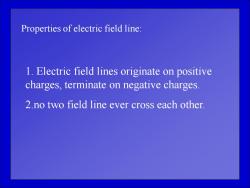
Properties of electric field line: 1.Electric field lines originate on positive charges,terminate on negative charges. 2.no two field line ever cross each other
Properties of electric field line: 1. Electric field lines originate on positive charges, terminate on negative charges. 2.no two field line ever cross each other
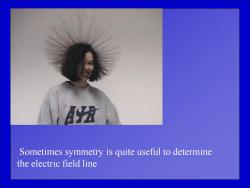
Sometimes symmetry is quite useful to determine the electric field line
Sometimes symmetry is quite useful to determine the electric field line

Example:Draw the electric field lines for a system that consists of two charges +2q and -q for j=-1*pi:pi/12:pi y(1)=0.2*sinG): x(1)=0.2*cos0房 fori=1:400 r(①=sqrt(x(①)2+y(①2) r1(i斤sqrt(x(i^2+(3-y(0)^2): x1(①=x(①/(r(①3)+2*x(①/(rl(①^3) y1(i)y(i)/r(①3)-2*(3-yi)/c1(①^3) y(i+1)y(①)+y1(①/x1(i①)*0.01 x(i+1)x(①+0.01;
Example: Draw the electric field lines for a system that consists of two charges , +2q and -q for j=-1*pi:pi/12:pi y(1)=0.2*sin(j); x(1)=0.2*cos(j); for i=1:400 r(i)=sqrt(x(i)^2+y(i)^2); r1(i)=sqrt(x(i)^2+(3-y(i))^2); x1(i)=x(i)/(r(i)^3)+2*x(i)/(r1(i)^3); y1(i)=y(i)/(r(i)^3)-2*(3-y(i))/(r1(i)^3); y(i+1)=y(i)+y1(i)/x1(i)*0.01; x(i+1)=x(i)+0.01;

ifx(1)0.0001)l(y(1)<0) plot(x,y); axis([-44-44]) hold on end end
if x(1)0.0001) | (y(1)<0) plot(x,y); axis([-4 4 -4 4]); hold on end end

4 3 3 -4 3 -2 0 2 3 4
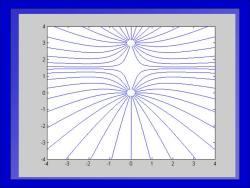
4 3 2 0 -2 -3 -4 3 -2 -1 0
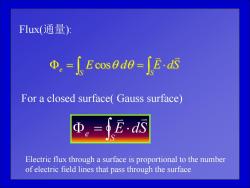
Fux(通量): =Fcos0de=E-d5 For a closed surface(Gauss surface) .=fE5 Electric flux through a surface is proportional to the number of electric field lines that pass through the surface
Flux(通量): S S e E d E dS cos For a closed surface( Gauss surface) S e E dS Electric flux through a surface is proportional to the number of electric field lines that pass through the surface
按次数下载不扣除下载券;
注册用户24小时内重复下载只扣除一次;
顺序:VIP每日次数-->可用次数-->下载券;
- 同济大学:《大学物理》课程教学资源(电子教案,英文版)第十七章 交流电路.pdf
- 同济大学:《大学物理》课程教学资源(电子教案,英文版)第十一章 热力学(下).pdf
- 同济大学:《大学物理》课程教学资源(电子教案,英文版)第二十章 光学(中).pdf
- 同济大学:《大学物理》课程教学资源(电子教案,英文版)第二十章 光学(下).pdf
- 同济大学:《大学物理》课程教学资源(电子教案,英文版)第二十三章 固体物理.pdf
- 同济大学:《大学物理》课程教学资源(电子教案,英文版)第二十一章 相对论.pdf
- 同济大学:《大学物理》课程教学资源(电子教案,英文版)原子物理2.pdf
- 同济大学:《大学物理》课程教学资源(电子教案,英文版)原子物理1.pdf
- 同济大学:《大学物理》课程教学资源(电子教案,英文版)第十章 气体动力论.pdf
- 同济大学:《大学物理》课程教学资源(电子教案,英文版)第十一章 热力学(上).pdf
- 同济大学:《大学物理》课程教学资源(电子教案,英文版)第六章 刚体的转动(下)..pdf
- 同济大学:《大学物理》课程教学资源(电子教案,英文版)第六章 刚体的转动(上)..pdf
- 同济大学:《大学物理》课程教学资源(电子教案,英文版)第八章 振动.pdf
- 同济大学:《大学物理》课程教学资源(电子教案,英文版)第九章 机械波(中).pdf
- 同济大学:《大学物理》课程教学资源(电子教案,英文版)第九章 机械波(下).pdf
- 同济大学:《大学物理》课程教学资源(电子教案,英文版)第九章 机械波(上).pdf
- 同济大学:《大学物理》课程教学资源(电子教案,英文版)第七章 引力.pdf
- 同济大学:《大学物理》课程教学资源(电子教案,英文版)第二章 质点的运动.pdf
- 同济大学:《大学物理》课程教学资源(电子教案,英文版)第三章 牛顿定律.pdf
- 同济大学:《大学物理》课程教学资源(电子教案,英文版)第一章 测量(负责人:王治国).pdf
- 同济大学:《大学物理》课程教学资源(电子教案,英文版)第十九章 电磁波.pdf
- 同济大学:《大学物理》课程教学资源(电子教案,英文版)第十二章 电场与电势(上).pdf
- 同济大学:《大学物理》课程教学资源(电子教案,英文版)第十二章 电场与电势(下).pdf
- 同济大学:《大学物理》课程教学资源(电子教案,英文版)第十五章 磁场(上).pdf
- 同济大学:《大学物理》课程教学资源(电子教案,英文版)第十五章 磁场(下).pdf
- 同济大学:《大学物理》课程教学资源(电子教案,英文版)第十八章 物质的磁性.pdf
- 同济大学:《大学物理》课程教学资源(电子教案,英文版)第十六章 电磁感应.pdf
- 同济大学:《大学物理》课程教学资源(电子教案,英文版)第十四章 直流电路.pdf
- 同济大学:《大学物理》课程教学资源(电子教案,英文版)量子1.pdf
- 同济大学:《大学物理》课程教学资源(电子教案,英文版)量子2.pdf
- 同济大学:《大学物理》课程教学资源(电子教案,英文版)量子3.pdf
- 安徽科技学院:《大学物理》课程教学资源(PPT课件)电学——第八章 静电场中的导体和电介质(Conductors and Dielectrics in Electrostatic Field).ppt
- 安徽科技学院:《大学物理》课程教学资源(PPT课件)电学——第十章 电势的计算.ppt
- 安徽科技学院:《大学物理》课程教学资源(PPT课件)电学——第九章 静电学——真空中的静电场(Electrostatic Field in Vacuum).ppt
- 安徽科技学院:《大学物理》课程教学资源(PPT课件)电磁学——第七章 真空中的静电场.ppt
- 安徽科技学院:《大学物理》课程教学资源(PPT课件)电磁学——第九章 真空中的稳恒磁场(Magnetic Field in Vacuum).ppt
- 安徽科技学院:《大学物理》课程教学资源(PPT课件)电磁学——第八章 静电场中的导体和介质.ppt
- 安徽科技学院:《大学物理》课程教学资源(PPT课件)第六章 狭义相对论.ppt
- 安徽科技学院:《大学物理》课程教学资源(PPT课件)电磁学——变化的电磁场.ppt
- 安徽科技学院:《大学物理》课程教学资源(PPT课件)电磁学——磁场对电流的作用.ppt
